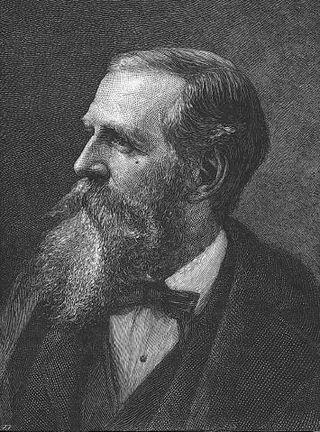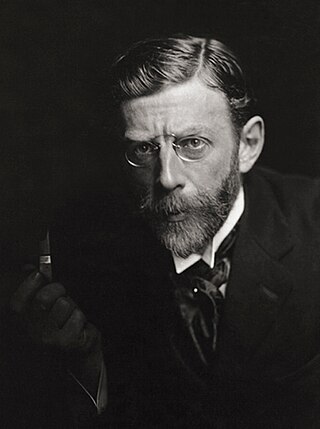
Jacob Armstead Lawrence was an American painter known for his portrayal of African-American historical subjects and contemporary life. Lawrence referred to his style as "dynamic cubism," an art form popularized in Europe which drew great inspiration from West African and Meso-American art. For his compositions, Lawrence found inspiration in everyday life in Harlem. He brought the African-American experience to life using blacks and browns juxtaposed with vivid colors. He also taught and spent 16 years as a professor at the University of Washington.

Frederic Edwin Church was an American landscape painter born in Hartford, Connecticut. He was a central figure in the Hudson River School of American landscape painters, best known for painting large landscapes, often depicting mountains, waterfalls, and sunsets. Church's paintings put an emphasis on realistic detail, dramatic light, and panoramic views. He debuted some of his major works in single-painting exhibitions to a paying and often enthralled audience in New York City. In his prime, he was one of the most famous painters in the United States.

Albert Bierstadt was a German American painter best known for his lavish, sweeping landscapes of the American West. He joined several journeys of the Westward Expansion to paint the scenes. He was not the first artist to record the sites, but he was the foremost painter of them for the remainder of the 19th century.

The Hudson River School was a mid-19th-century American art movement embodied by a group of landscape painters whose aesthetic vision was influenced by Romanticism. Early on, the paintings typically depicted the Hudson River Valley and the surrounding area, including the Catskill, Adirondack, and White Mountains.

The Ashcan School, also called the Ash Can School, was an artistic movement in the United States during the late 19th-early 20th century that produced works portraying scenes of daily life in New York, often in the city's poorer neighborhoods.

William Hart, was a Scottish-born American landscape and cattle painter, and Hudson River School artist. His younger brother, James McDougal Hart, and his younger sister, Julie Hart Beers, were also Hudson River School artists, and his nieces Letitia Bonnet Hart and Mary Theresa Hart became well-known painters as well. Another niece, Annie L. Y. Orff, became an editor and publisher. He studied under Jules-Joseph Lefebvre.

Jervis McEntee was an American painter of the Hudson River School. He is a lesser-known figure of the 19th-century American art world, but was a close friend and traveling companion of several of the important Hudson River School artists. Aside from his paintings, McEntee's unpublished journals, written from 1872 to 1890, are an enduring legacy, documenting the life of a New York painter during and after the Gilded Age.

Thomas Doughty was an American artist associated with the Hudson River School.

William Trost Richards was an American landscape artist. He was associated with both the Hudson River School and the American Pre-Raphaelite movement.

Robert Swain Gifford was an American landscape painter. He was influenced by the Barbizon school and became a member of the Society of American Artists.
James Renwick Brevoort was an American artist known for his landscapes painted in the Hudson River School style.

David Johnson was an American painter, a member of the second generation of Hudson River School painters.

Classical Realism is an artistic movement in the late-20th and early 21st century in which drawing and painting place a high value upon skill and beauty, combining elements of 19th-century neoclassicism and realism.

Leon Dabo was an American tonalist landscape artist best known for his paintings of New York, particularly the Hudson Valley. His paintings were known for their feeling of spaciousness, with large areas of the canvas that had little but land, sea, or clouds. During his peak, he was considered a master of his art, earning praise from John Spargo, Bliss Carman, Benjamin De Casseres, Edwin Markham, and Anatole Le Braz. His brother, Scott Dabo, was also a noted painter.

Graydon Parrish is a realist painter living in Austin, Texas. He is both trained in and an exponent of the atelier method which emphasizes classical painting techniques.

John Nelson Shanks was an American artist and painter. His best known works include his portrait of Diana, Princess of Wales, first shown at Hirschl & Adler Gallery in New York City, April 24 to June 28, 1996 and the portrait of president Bill Clinton for the National Portrait Gallery.

Deborah Remington was an American abstract painter. Her most notable work is characterized as Hard-edge painting abstraction.
John Lees is an American contemporary expressionist artist who works primarily in painting.

Thornton Willis is an American abstract painter. He has contributed to the New York School of painting since the late 1960s. Viewed as a member of the Third Generation of American Abstract Expressionists, his work is associated with Abstract Expressionism, Lyrical Abstraction, Process Art, Postminimalism, Bio-morphic Cubism and Color Field painting.
Gregory Amenoff is an American painter. He is located in the tradition of the early American Modernist painters Georgia O'Keeffe, Charles Burchfield, Milton Avery, Arthur Dove and Marsden Hartley. In the early 80s his work was often associated with a style of painting called organic abstraction and exhibited alongside artists Bill Jensen, Katherine Porter and Terry Winters.


















